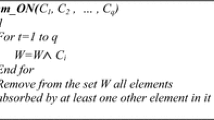Abstract
In this paper, we present reduction algorithms based on the principle of Skowron’s discernibility matrix — the ordered attributes method. The completeness of the algorithms for Pawlak reduct and the uniqueness for a given order of the attributes are proved. Since a discernibility matrix requires the size of the memory of |U|2,U is a universe of objects, it would be impossible to apply these algorithms directly to a massive object set. In order to solve the problem, a so-called quasi-discernibility matrix and two reduction algorithms are proposed. Although the proposed algorithms are incomplete for Pawlak reduct, their optimal paradigms ensure the completeness as long as they satisfy some conditions. Finally, we consider the problem on the reduction of distributive object sets.
Similar content being viewed by others
References
Pawlak Z. Rough Set — Theoretical Aspects of Reasoning about Data. Kluwer Academic Publishers, Dorderecht, Boston, London, 1991.
Skowron A, Rauszer C. The Discernibility Matrices and Functions in Information Systems. Intelligent Decision Support — Handbook of Applications and Advances of the Rough Sets Theory, Slowinski R (ed.), 1991, pp.331–362.
Wang J, Miao D. Analysis on attribute reduct strategies of rough set.Journal of Computer Science and Technology, 1998, 13(2): 189–193.
Wang J, Wang R, Miao Det al. Data enriching based on rough set theory.Chinese Journal of Computers, 1998, 21(5): 393–400.
Wang J. Rough Sets and Their Applications in Data Mining. Fuzzy Logic and Soft Computing, Chen G (ed.), Kluwer Academic Pub., 1999, pp.195–212.
Quilan J. Induction of Decision Trees. Machine Learning 1, 1986, pp.81–106.
Utgoff P. ID5: An Incremental ID3. InProceeding of ICML-88, Ann Arbor, MI: Morgan Kaufmann 1988, pp.107–120.
Polkowski L, Skowron A. Rough Sets: Perspectives. Rough Sets in Knowledge Discovery 1, Polkowski L, Skowron A (eds.), Physica-Verlag, 1998, pp.1–27.
Author information
Authors and Affiliations
Corresponding author
Additional information
This work is supported by the National Key Project for Basic Research on Image, Speech, Natural Language Understanding and Knowledge Mining (NKBRSF, No. G1998030508), the National ‘863’ High-Tech Programme and the National Natural Science Foundation of China.
WANG Jue is a professor of computer science and artificial intelligence at Institute of Automation, The Chinese Academy of Sciences. His research interests include artificial intelligence, artificial neural network, machine learning and knowledge discovery in databases.
WANG Ju is a professor of computer science at Institute of Software, The Chinese Academy of Sciences. His research interests include logic and its applications in artificial intelligence and computer science.
Rights and permissions
About this article
Cite this article
Wang, J., Wang, J. Reduction algorithms based on discernibility matrix: The ordered attributes method. J. Comput. Sci. & Technol. 16, 489–504 (2001). https://doi.org/10.1007/BF02943234
Received:
Revised:
Issue Date:
DOI: https://doi.org/10.1007/BF02943234




